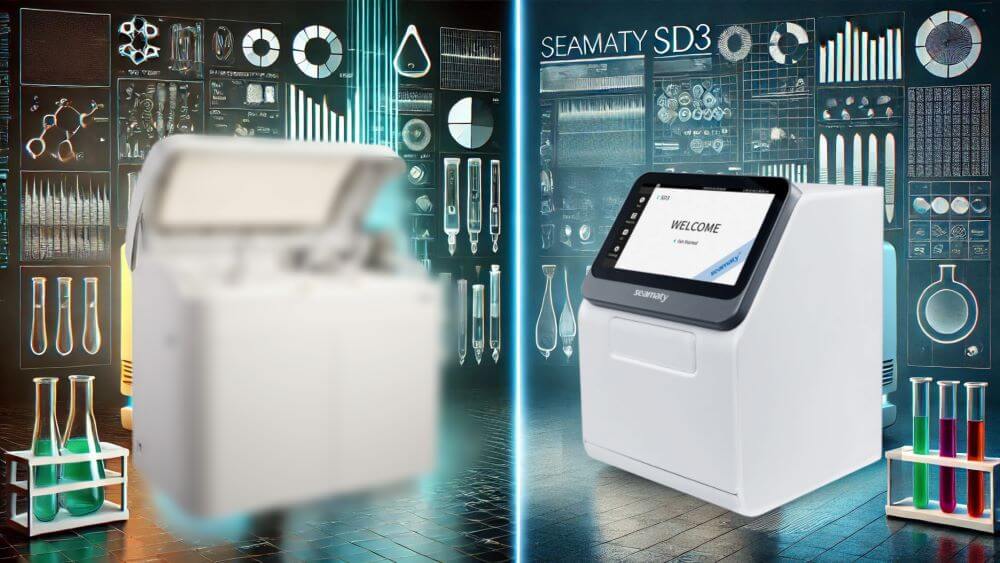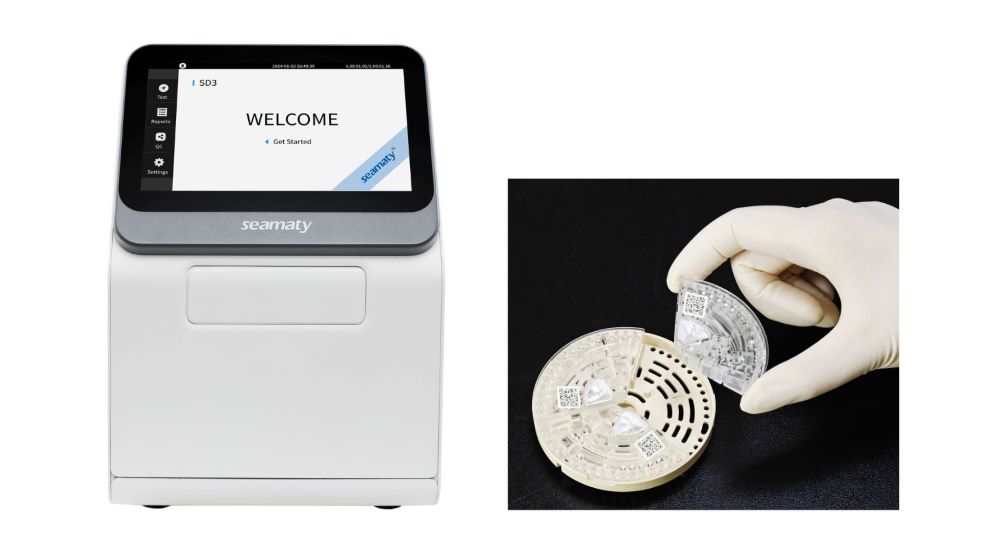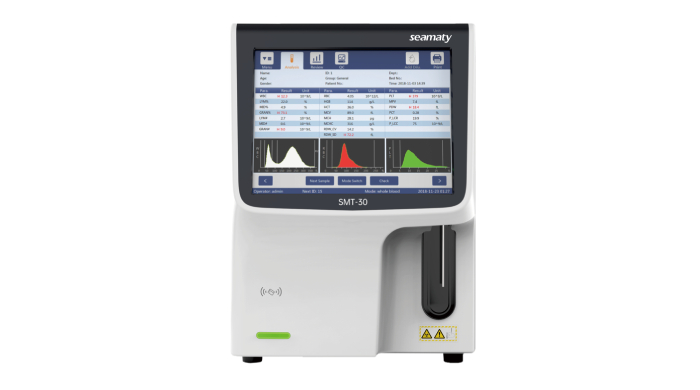release time:2024-11-05 14:41:11
For decades, traditional chemistry analyzers have been the workhorses in laboratories. However, the Seamaty SD3 has emerged as a revolutionary alternative. This article aims to compare the SD3 with traditional chemistry analyzers and highlight why the SD3 is the superior choice.

Seamaty SD3
The Seamaty SD3's microfluidics technology is at the heart of its remarkable accuracy. This advanced technology allows for precise handling of whole blood, serum, and plasma. The patented single-use reagent discs are another key factor. Their design ensures that each test is conducted with high precision, providing consistent and reliable measurements. Multiple studies have shown that the SD3 can achieve an accuracy level that rivals, if not surpasses, traditional analyzers.
Traditional Chemistry Analyzers
Traditional analyzers typically rely on well-established but sometimes less precise methods for sample analysis. Sample handling can be a significant source of error. Issues such as improper calibration and reagent instability can also affect the accuracy of results. In many cases, research has demonstrated that traditional analyzers may not provide the same level of accuracy as the SD3 dry chemistry analyzer, especially in complex or challenging sample scenarios.
Seamaty SD3
The SD3's 4-step operation process is a game-changer. It simplifies the analysis procedure and enables quick turnaround times. The design of the reagent discs and the internal mechanisms of the analyzer work in harmony to rapidly process samples. Data shows that for various types of tests, the SD3 can complete analyses in a fraction of the time compared to traditional methods.
Traditional Chemistry Analyzers
Traditional analysis methods often involve complex workflows with numerous time-consuming steps. Sample preparation can be elaborate, and reaction times may be longer. Bottlenecks in the process, such as the need for multiple manual interventions, can significantly slow down the overall speed of analysis. When compared to the SD3 using industry-standard tests, traditional analyzers fall behind in terms of speed.
Seamaty SD3
The single-use reagent discs of the SD3 offer long-term cost-effectiveness. They eliminate the need for extensive and costly maintenance associated with traditional analyzers. There's no need for regular and elaborate cleaning or calibration procedures that are common with traditional systems. When considering the overall cost per test, including reagent consumption, equipment depreciation, and labor, the SD3 proves to be a more economical option.
Traditional Chemistry Analyzers
Traditional analyzer reagents come with their own set of costs. Storage requirements, disposal issues, and potential waste due to reagent instability can add up. Additionally, maintenance and repair costs, including regular calibration, replacement of parts, and servicing, can be substantial. Over a specific period, the total cost of ownership of traditional analyzers is often higher than that of the SD3.
Seamaty SD3
The simplicity of the SD3's 4-step operation cannot be overstated. Its user-friendly design includes an intuitive interface that requires minimal training for laboratory staff. The straightforward operation allows for easy integration into existing laboratory workflows, reducing the learning curve and potential for errors.
Traditional Chemistry Analyzers
Operating traditional analyzers can be complex. Specialized training is often required for sample preparation, instrument operation, and result interpretation. Adjusting these analyzers for different types of tests or samples can be challenging, leading to a steeper learning curve and increased complexity compared to the SD3.
Seamaty SD3
The SD3's ability to handle whole blood, serum, and plasma with ease is a significant advantage. Moreover, it can accommodate additional sample types and special conditions. The flexibility of the reagent discs allows for a wide range of tests to be performed on different samples, making it a versatile choice for various laboratory needs.
Traditional Chemistry Analyzers
Traditional analyzers have limitations when it comes to the types of samples they can handle. Adapting them to new or unusual sample matrices can be difficult, restricting their versatility compared to the SD3.
Three Types of Discs
The SD3 offers three distinct types of discs: round discs, fan-shaped discs, and circular arc type discs. This unique feature allows for the simultaneous testing of three samples at once. In a laboratory environment, this multi-sample testing capability translates to increased throughput and enhanced efficiency. It enables laboratories to process more samples in less time, reducing backlogs and improving overall productivity.
OEM Test Parameters Combination Reagent Discs
The SD3 also provides OEM test parameters combination reagent discs. With an impressive 58 test parameters available, this customization option is a game-changer. Laboratories can now tailor the analyzer to their specific testing requirements. This level of customization ensures that the SD3 can meet the diverse needs of different medical and research settings, something that traditional analyzers often struggle to achieve.
|
Comparison Point |
Seamaty SD3 |
Traditional Chemistry Analyzers |
|
Accuracy of Results |
Microfluidics technology and patented single-use reagent discs ensure high accuracy with whole blood, serum, plasma. Studies support its precision. |
Prone to errors from sample handling, calibration issues, and reagent instability. May be less accurate in complex scenarios. |
|
Speed of Analysis |
4-step operation and design enable quick analysis. Data shows fast processing times for various tests. |
Complex workflows with time-consuming sample prep and longer reaction times. Slower than SD3 in standard tests. |
|
Cost-effectiveness |
Single-use discs reduce long - term costs by eliminating extensive maintenance. Overall cost per test is lower considering all factors. |
High costs from reagent storage, disposal, instability, and maintenance/repair. Total cost of ownership is higher. |
|
Ease of Use |
Simple 4-step operation, intuitive interface, and easy integration. Minimal training required. |
Complex operation needing specialized training. Difficult to adjust for different tests/samples. |
|
Sample Compatibility and Versatility |
Handles whole blood, serum, plasma well and can accommodate more sample types. Reagent disc flexibility allows diverse tests. |
Limited in sample types. Challenges adapting to new or unusual samples. |
|
Unique Disc Options |
Three types (round, fan-shaped, circular arc) for 3-sample simultaneous testing. OEM discs with 58 parameters for customization. |
No such features. |
In conclusion, the comparison between the SD3 and traditional chemistry analyzers clearly shows the superiority of the SD3. It excels in terms of accuracy, speed, cost - effectiveness, ease of use, sample compatibility, and the unique features offered by its diverse disc options and customization capabilities. For laboratories and medical facilities looking to upgrade their analysis capabilities, the SD3 is an outstanding choice that can bring significant improvements to their operations and the quality of results they obtain.
Related further reading:
1. The Technology and Principles of the SD3 Fully Automated Dry Chemistry Analyzer
2. Cut Costs, Boost Efficiency: The Automatic Chemistry Analyzer With Fan-Shaped Reagent Panels
3. Three Tests in One: Revolutionize POCT with Seamaty SD3 Dry Chemistry Analyzer
4. 12 FAQs of Seamaty SD3 Fully Automated Dry Chemistry Analyzer

2024-06-06
Discover the advanced technology and principles behind the SD3 Fully Automatic Dry Biochemical Analyzer. Learn how its microfluidic and dry biochemical analysis, combined with a unique reagent disk design, offer efficient, accurate, and compact solutions for modern biochemical testing in medical, biological, and chemical research settings.

2022-07-21
CBC machine is also called hematology analyzer, hemocytometer, blood cell counter, etc. cbc machine is one of the most widely used instruments in hospital clinical testing.

2021-11-04
Microfluidic chip technology is the cornerstone of biochips. It integrates the processes involved in sample pretreatment, biochemical reactions, sorting and detection in the fields of chemistry, biology and medicine into a few square centimeters of chip through multidisciplinary intersection.